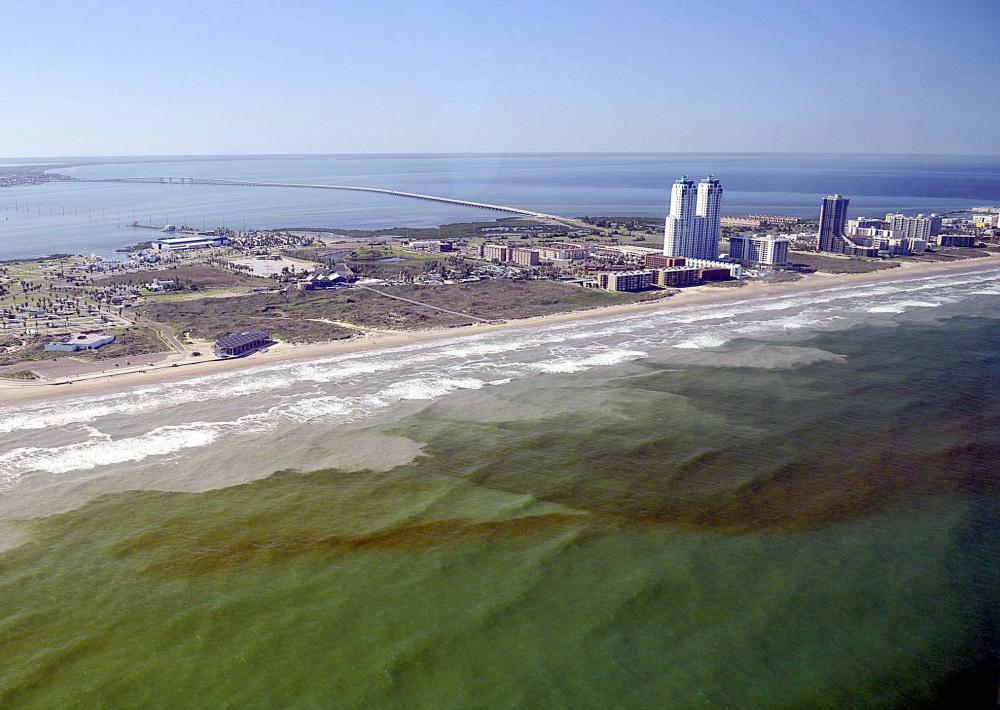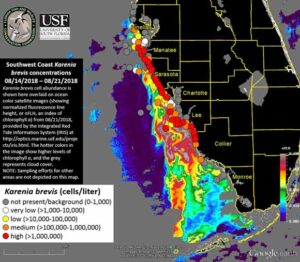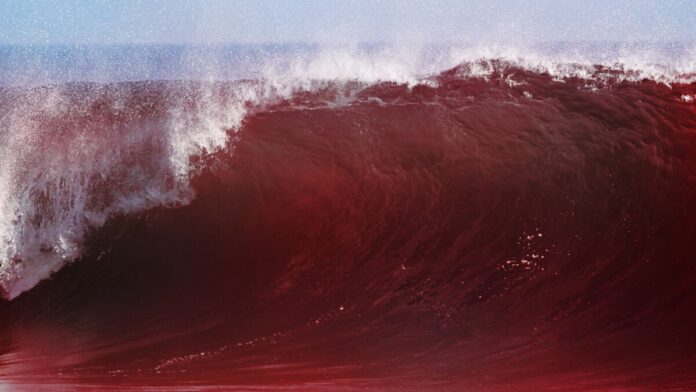During Florida’s annual “wet” season, from May through October each year, over 40 inches of rainwater falls in the center of the sunshine state – 70% of Florida’s annual precipitation. Most of that rain drops on land in the north Florida watershed, above Lake Okeechobee and then gradually flows southward across cattle pastures, leaky septic-tank ridden residential communities, commercial vegetable gardens, and through a gauntlet of sewage sludge storage farms that have been filled to capacity with discarded dried-up human waste.
Once this phosphorous laden and nutrient rich water reaches Lake Okeechobee it stagnates, heats up and breeds algae. Each year when Lake O. gets filled to the brim from summer storms that put pressure on the aging Hoover Dike dam, the floodgates are opened and the water gets released through east and west canals leading into the Gulf of Mexico and the Atlantic Ocean.
When the algae tainted hyper nutrient laden fresh water from Lake Okeechobee flows into salt water estuaries and the open ocean it devastates fish and other wildlife populations that depend on sea water to survive. It also has been loosely linked to increasing occurrences of red tide.
Red-tide has been blamed on farmers fertilizers, septic tanks, cattle ranches and even, in 1947, the military was accused of causing massive outbreaks of red-tide in Florida from leftover World War II gases and chemicals thought to have been dumped into the Gulf of Mexico by the U.S. military.
Red tide has been recorded in and around Florida from at least the 16th century. One of the earliest known accounts of Florida red tide comes from a Spanish explorer who told stories he heard from Florida Indians of toxic “red water” and the resulting death of birds and fish.
Red Tide seems to be a naturally occurring phenomenon, but can be intensified by man made influences.

Regardless of the many potential contributors to the phosphorous and nitrogen runoff going into and out of Lake Okeechobee, there is only one real cause of the green algae – It’s called sewage sludge.
Sewage sludge is the solid waste material that comes out of every toilet in a municipality that gets flushed into a local ‘treatment facility’ where it is separated into either a solid or a liquid. The leftover, partially treated, liquid usually gets pumped back into the local waterways, but the poo is a problem. It smells bad, it attracts insects and it contains many harmful heavy metals and nutrients that have been attributed to causing disease, green algae blooms – and Valley Fever.

Most municipalities export their human waste to another county, or state, to get it out of their own back yard. Jim Waymer, from Florida Today, described the stench of a sewage sludge storage area, stating, “The stink and the flies still lead the way to Palm Beach County farmland that has become a dumping ground for Broward County sewage sludge. Complaints about overwhelming odors and ‘horrific’ conditions last year triggered inspections by Palm Beach County officials revealing that tons of treated human waste was being disposed of at Dan Griffin Sod Co.’s land near South Bay.” Palm Beach County Code Enforcement Director Ramsay Bulkeley inspected the disposal site after receiving complaints about the odor. Bulkeley reported that it was so “disgusting” that “you couldn’t bear to smell.”
Former Florida Department of Environmental Protection administrator for Martin County, Gary Roderick, considers the sewage sludge to be the largest contributor to Indian River Lagoon pollution. Roderick said, “This is like a sleeping giant that’s causing a silent scream in the lagoon. It’s the 5,000-pound gorilla that’s not saying anything right in the middle of the room. Spreading sludge on rural lands may pose a long-term risk for the lagoon and other Florida waterways. While it’s uncertain how much nitrogen and phosphorus from sludge reach the lagoon, the amount could be significant.”
County sewage treatment facilities process the poo slurry into several categories of solid waste material. After processing, the dried sludge gets rated at either AA, A or B grades of contamination, depending on the quality of each county’s sewage facility. AA rated waste has most of the hazardous heavy metals removed but still contains dangerous pathogens and levels of phosphorus and nitrates that cause green algae blooms in Florida’s freshwater environments. Class A an B sludge is the most dangerous form of treated human waste and it is routinely discarded throughout the interior of Florida and throughout the northern watershed where the tainted runoff water ultimately flushes into Lake Okeechobee and all of the waterways downstream of the disposal sites.
In a research report from 2009, the Florida Audubon group found that “Class AA and B biosolids contain an average of 5.5 percent of nitrogen and 2.2 percent of phosphorus” – which are the main ingredients for the formation of green algae, along with sunlight and oxygen.

According to the Department of Environmental Protection biosolids report, Osceola County, which is located directly above Lake Okeechobee, has seven sewage sludge storage areas that cover over 17,000 acres. In 2013 alone, over 51,000 tons of class B sewage sludge was deposited on Osceola county land.
Each county in the state has to find a way to dispose of their own sewage. Until mandates are put in place to modernize sewage treatment facilities on a mass scale, throughout the entire state, each county will continue to contaminate the environment.
The 2013 biosolids report detailed some of the Sewage Sludge Storage Areas that are located on the east side of central Florida, near some of Florida’s most protected and endangered estuaries. They include:
Osceola County:
3,603 tons of sewage sludge on 513 acres on the Cecil Whaley Ranch
10,628 tons of sewage sludge on 1,105 acres on the Clay Whaley Ranch
905 tons of sewage sludge on 665 acres on the Crescent J Ranch
13,517 tons of sewage sludge on 5,735 acres on the Deer Park Ranch
10,700 tons of sewage sludge on 2,394 acres on the Deseret Ranches
10,791 tons of sewage sludge on 4,513 acres on the Hayman 711 Ranch
1,575 tons of sewage sludge on 2,551 acres on the Kenansville Ranch
Brevard County:
169 tons of sewage sludge on 200 acres in Jakubcin
44 tons of sewage sludge on 85.5 acres in Port St. John
Volusia County:
374 tons of sewage sludge on 115 acres on the Hart Property
Indian River County:
4,072 tons of sewage sludge on 2,336 acres on the Corrigan Ranch
1,365 tons of sewage sludge on 651 acres on the Flying L Ranch
1,291 tons of sewage sludge on 432 acres on the Ox Creek Ranch
5,744 tons of sewage sludge on 3,059 acres on the Pressley Ranch
The Florida department of Environmental Protection has recently confirmed that more than 70,000 tons of sewage sludge was permitted in 2016 to be deposited within the Upper Basin of the St. Johns River – Florida’s longest river, running 310 miles between Vero Beach and the Atlantic ocean.
Maggy Hurchalla, a lagoon advocate from Martin County is concerned about all of the misinformation being propagated about the causes of algae in the estuaries and red tide on the coastline. She blamed green algae blooms in Lake Okeechobee and elsewhere on the over 300,000 dry tons of sewage sludge being deposited on land in the center of the state, which she contends contributes to over 33 million pounds of nitrogen and more than 13 million pounds of phosphorus into the state’s waterways each year – far more than agricultural crops or cattle pastures could ever produce.
